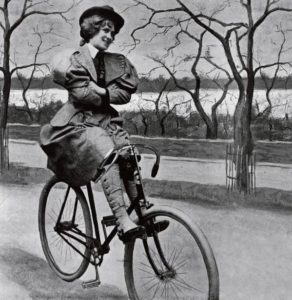Greenville successfully enjoyed the 22nd Annual Cotton Patch Challenge Bicycle Rally in downtown this weekend. But can you imagine such an event becoming a moral controversy? Bicycling became a favorite sport throughout the midwestern United States in the 1890s. Young men formed clubs, some daring young ladies joined in as the trend became something of a political and religious controversy.
The League of American Wheelmen (LAW) founded by cyclists in 1887 spread rapidly across the country, especially in the north. Their influence sparked the movement of better roads, but we’ve already seen that project reach fruition. 1896 was an election year; William Jennings Bryant, the perennial Democratic candidate, again ran for president. The Republican candidate William McKinley was not a strong campaigner. He was a home body who disliked the thought of crossing the nation in a railway car.
To counter this disparity, the Republican Party introduced a political faction known as the Bicycle Bloc to campaign for McKinley. More than 70,000 young men were swing voters who agreed to hand out buttons and give speeches as they rode through the countryside. They were particularly successful in Michigan and Ohio. Few made their ways south, maybe the summer heat or the stuffier environment had something to do with that.
Seeing how much fun their male friends were having intrigued many young women. It was a means of freedom in a way. Soon young women and girls were riding this new kind of mobility. They relished unchaperoned dates; even elopements on bicycles. In Boston, after the closure of brothels, prostitutes rode bicycles to reach clients. But most upsetting to the older generation was the fact that these young women wore bloomers! It was disgraceful!
Bloomers were cut like men’s pants but much fuller. They allowed females to ride astride a bicycle or horse. Yet, the very idea of such clothing for the fairer sex was terribly indecent. Many a mother bemoaned the style and fretted over what the world was coming to.
The 1890s identified the Gilded Age, with thousands of laborers crowded into industrial cities and towns. Sunday was the only work-free day for the vast majority of people. Youngsters and young adults much preferred to spend their free time cycling over the country side and through towns than attending church. The number of men attending church services was on a decline, threatening to leave preachers with congregations of only sick and elderly souls.
Opponents of bicycles claimed the sport was unhealthy and vicious. Yet, supporters rebutted, cycling built courage, determination, and strength. An added plus was that cycling was a definite alternative to saloons and gaming houses.
In 1903 Henry Ford introduced the assembly line to automobile manufacturers, including himself. And BOOM! Cars became the In-Thing, what everybody had to have. Abruptly bicycles became the mode of transportation for the working class. Automobiles were King of the Road.
Did Greenville youth take to bicycling? It’s unclear but the odds are pretty strong that the sport was popular at Mayo’s College in Commerce. His wife Etta was always up for new ideas, especially for women.

